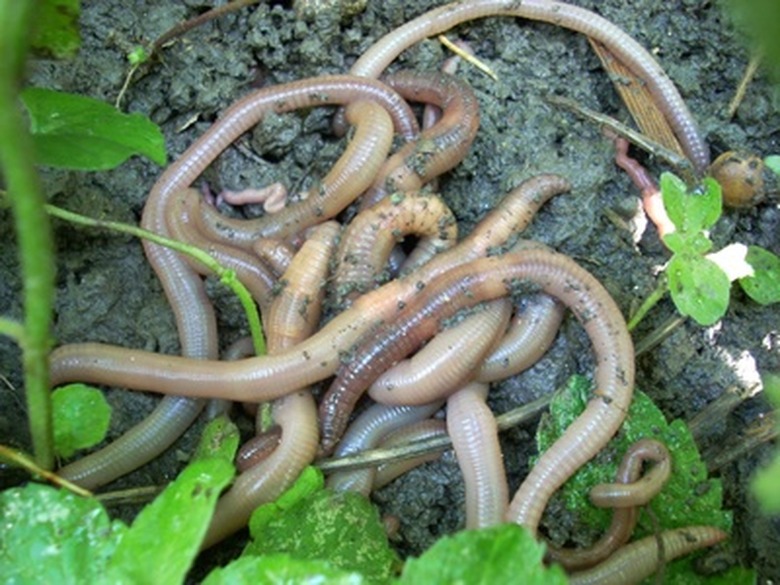Why Does An Earthworm Have A Closed Circulatory System?
Earthworms have what are called closed circulatory systems. Closed circulatory systems are those in which the blood is kept in a closed system of vessels, like in humans.
Open circulatory systems are when the blood is pumped into a body cavity called a hemocoel, allowing the blood to surround the organs. Vertebrates and some invertebrates have closed systems while mollusks, arthropods and other invertebrates have open systems.
Worm Locations
Worm Locations
Species of worms are found all across the globe. Earthworms live in moist soils. Worms can also live in aquatic environments; these aquatic worms share a similar type of anatomy with earthworms.
Earthworm Anatomy
Earthworm Anatomy
Annelida, the name of the phylum earthworms are in, means "little rings" in Latin. "Little rings" is an excellent way to describe earthworms as their bodies are made up of 100 to 150 different segments. These segments help the earthworm move through their environment by independently contracting and releasing the muscles in each section. Small hairlike structures called setae, on the outside of an earthworm's body, help to keep it on its path.
In the center of the body of the earthworm lies its digestive system, running from the mouth to the anus. Each section of the worm's digestive tract has different functions, which allows the earthworm to break down and absorb nutrients from the soil for food.
Earthworms do not have lungs; instead, they absorb oxygen and expel carbon dioxide through their moist skin and in and out of their blood and body tissues.
Earthworm Reproduction
Earthworm Reproduction
Interestingly, earthworms are hermaphrodites, which means they have both male and female sex organs. When they find a mate, they produce slime from their clitellum, the smooth section visible on earthworms bodies.
The earthworms then rub alongside each other's bodies, transferring eggs and sperm into the slime tube. The slime tube then closes off and stays in the soil for the baby earthworms to develop.
Earthworm Circulatory System
Earthworm Circulatory System
Earthworms have a basic closed circulatory system running the length of their bodies. Earthworms' blood vessels run throughout their segments, carrying vital oxygen and nutrients to all their organs.
Aortic arches, dorsal blood vessels and ventral blood vessels are the three main types of vessels found in an earthworm's closed circulatory system.
Aortic Arches
Aortic Arches
Earthworms have five pairs of aortic arches that wrap around the esophagus to form the heart. **Their aortic arches are sometimes referred to as pseudo-hearts.**
The arches' job is to receive blood from the ventral blood vessels and pump it back to the dorsal blood vessels.
Dorsal Blood Vessels
Dorsal Blood Vessels
Dorsal blood vessels are located along the top of the earthworm's body. These vessels contract to shift blood from the aortic arches down towards the end of the body of the earthworm.
Connected capillary beds transfer nutrients and oxygen from the ventral blood vessels to the earthworm's body tissues and organs.
Ventral Blood Vessels
Ventral Blood Vessels
Like the name suggests, the ventral blood vessels are found on the underside of the earthworm's body. The ventral blood vessel function is to move the blood back towards the aortic arches.
During a dissection, you'll see the dark-brownish red color of these vessels.
Ecological Importance of Earthworms
Ecological Importance of Earthworms
Earthworms help both plants and animals survive. As decomposers, they play a vital role in breaking down dead or decaying plant and animal matter to help nutrients like phosphorus and nitrogen become bioavailable to plants. They are also an important food source for animals and are at the base of the food web for many birds, mammals, reptiles, amphibians and other invertebrates.
By eating and digesting soil, earthworms change its structure and nutrient content. This makes earthworms "ecosystem engineers." By digging through soil, earthworms aid aeration and help water filter down through the soil. Improving soil conditions makes earthworms very important to humans for enhancing the success of agricultural crops.
References
- Georgia State University: Closed and Open Circulatory System
- University of Pennsylvania: Earthworms
- Science Learning Hub: Inside of an Earthworm
- University at Buffalo: The Earthworm
- Biology Junction: Earthworm Anatomy and Dissection Guide
- Science Learning Hub: Earthworms' Role in the Ecosystem
- Reference*: What Animals Eat Earthworms
- BioKids: Oligochaeta
Cite This Article
MLA
Jerrett, Adrianne. "Why Does An Earthworm Have A Closed Circulatory System?" sciencing.com, https://www.sciencing.com/earthworm-closed-circulatory-system-6787995/. 31 July 2019.
APA
Jerrett, Adrianne. (2019, July 31). Why Does An Earthworm Have A Closed Circulatory System?. sciencing.com. Retrieved from https://www.sciencing.com/earthworm-closed-circulatory-system-6787995/
Chicago
Jerrett, Adrianne. Why Does An Earthworm Have A Closed Circulatory System? last modified August 30, 2022. https://www.sciencing.com/earthworm-closed-circulatory-system-6787995/
